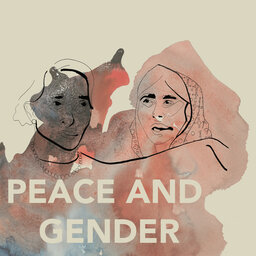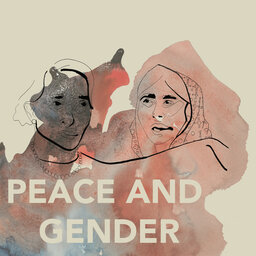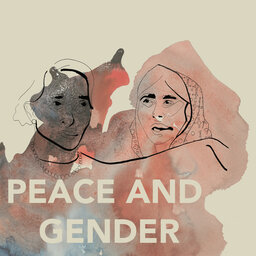Andrea Thiis-Evensen meets Dr Maria Tanyag, who specialises in the neglect of women’s sexual health in crisis areas, and examines the major consequences this neglect can have on society.
EPISODE TRANSCRIPT
Andrea Thiis-Evensen: Hey, my name is Andrea Thiis-Evensen and welcome back to Peace and Gender. In this podcast I am trying to highlight the issues surrounding gendered inequalities.
I’m doing this by meeting the people who are actually seeking solutions, trying to get to know both their research and their personal story.
These topics may not meet the mainstream media agenda, but they are issues that really deserve attention.
Maria Tanyag: You have women who could have lived had they had access to health.
Andrea Thiis-Evensen: Today I’m going to talk to Dr Maria Tanyag about the issues around women’s sexual health. Maria is a feminist researcher and she has a PhD in politics and international relations.
But first, why did Maria start looking into this issue?
Maria Tanyag: Growing up in the Philippines I was specifically motivated to do further research because of the - what I was then observing as gender-specific barriers to women’s health. We have among the strictest laws around abortion, access to contraception.
For me, growing up - especially as I was also developing as a person and as a woman, I was seeing these and noticing these inequalities more because it’s very personal and as most feminists would say, the personal is political.
When I was starting to observe all these inequalities that women distinctly faced, I was prompted to understand, what are the reasons why these barriers are there in place?
Andrea Thiis-Evensen: Despite how far she thought we’d come when it came to gender inequality, Maria started seeing all these inequalities when it came to women and equality.
Maria Tanyag: While there is a global push to promote gender equality, and we’ve made significant progress already, we are still yet to understand why many women, and girls, die from pregnancy related complications.
Why, despite a broad support and understanding that gender equality matters, we are still seeing the prevalence of, for most parts, preventable maternal deaths in many societies. That to me is a fundamental inequality and it’s a paradox, that we can see a lot of women in many societies, sometimes within the same society, progressing.
Yet you have women who could have lived had they access to health care, reliable health information around their own bodies. That is, for me, a global problem that needs urgent attention.
Because if we have - if we do not bridge that health gap we are seeing a lot of progress being built on the invisible deaths and sacrifices of women, especially those in crisis settings, who are enduring a lot of this specific violence because of all these broader politics and inequalities that prevent them from accessing health.
Andrea Thiis-Evensen: This is what Maria started researching.
Maria Tanyag: There’s a lot of talk about inclusive post-disaster recovery, inclusive peace building, and all of these things are important and they matter, but for me the question is why, in all of these things, the hierarchy always put women’s health at the bottom?
There seems to be a deliberate neglect, or forgetting that women for women to be able to fully participate in political and economic decision making, they must also, in the first place, be able to have control and decision making over their own bodies.
So my research has really shown that women and girls, through dominant peace and security development agendas are being made responsible as well in post-disaster and post-conflict recovery and rehabilitation. But it is being built on their invisible sacrifices because we are not recognising the contributions that they are making.
One evidence of that lack of recognition is the lack of support towards sexual and reproductive health, which is so fundamental.
Andrea Thiis-Evensen: Even in Australia, if you have gotten an abortion in New South Wales or Queensland, you may actually risk criminal charges.
Maria Tanyag: Why is there, up until now and Australia has got a feminist foreign policy or is moving towards being known for having a feminist foreign policy too. But internally, domestically, there are a lot of ongoing debates around abortion rights in Australia.
Again there’s a disconnect between - okay we want women to pursue and rise up to the challenge of governance, political governance. But in everyday life, many women face restrictions to reproductive decision making.
That’s something that I’m very interested in, understanding why there is a disconnect and what does that mean for how we are progressing for gender equality more broadly.
Andrea Thiis-Evensen: So although we’ve come a long way today when it comes to gender equality some inequalities have been overlooked or forgotten, especially in crisis areas.
Maria Tanyag: In the Philippines again it’s a very interesting case because we have got a lot of very good gender equality laws. In fact we have been a regional leader in terms of promoting gender equality in security and development agendas.
We have got a lot of very strong prominent women in politics as well, but we need to make sure that that is equalised. Especially for those in situations of crisis, in times of disasters and conflicts, that we are not forgetting that there are gender specific inequalities that women and girls face and it’s rooted to [inequal] [sic] access to health.
Andrea Thiis-Evensen: Maria has been looking at women in areas of conflict and in areas of crisis, and she says that these two are interconnected.
Maria: In the Philippines, violence is seasonal and disasters are violent. So there’s an interesting overlap that showed me some surprising findings, that conflicts are shaped by weather patterns. They are influenced by resource shortages, they are influenced - conflicts erupt intermittently depending on when an election is supposed to occur because it’s about control over power and resources.
So people know the likelihood of when a conflict will erupt and when it won’t. It’s kind of like an early warning system, which normally we understand for weather patterns, but they were understanding it in the context of conflicts.
Similarly, in the case of disasters, people, especially in - again the Philippines is a very disaster-prone country - in a disaster-prone region, they were saying that disasters are increasingly violent.
Many forms of violence, whether physical or structural violence are experienced in times of disasters. So for them disasters are equally violent and there are specific conflicts that are triggered by disasters.
For instance, when there are shortages in the distribution of relief assistance communities tend to have infighting among themselves because of jealously and rivalry and status hierarchies, depending on who has access to what resources as part of disaster relief.
Andrea Thiis-Evensen: When Maria did her PhD in the Philippines she heard all these stories from women experiencing inequality in post-disaster and conflict areas.
Maria Tanyag: For me what really struck me were stories of women giving birth in internal displacement camp. One anecdote of a woman who described herself as - it’s very gruesome, but she described herself as a pig or cattle where she was giving birth, and because it was in a cramped space, other people were watching her give birth, like a show, like an exhibit.
For her that made it more traumatic than the conflict itself that displaced her. Because it dehumanised her. Pregnancy for most people is a special moment, and giving birth is a special moment. Maybe between spouses or couples and celebrated by families.
But in conditions where it’s inhumane and unsafe, giving birth contributes to a loss of dignity and can actually heighten the risk of death. These are deaths that can occur long after a conflict has erupted, or even after a disaster has happened.
For me what was really, in a way heartbreaking but motivates the kind of work we do, is understanding these women and communities have survived disaster and have survived conflict, but they end up dying because of protracted displacement. Isn’t that something that is really unjust? Especially if it could have been prevented if we can be better at doing humanitarian or security responses.
Andrea Thiis-Evensen: There are many feminist movements happening, but some of these movements can actually be counterproductive to gender equality.
Maria Tanyag: We need to be able to create distinctions between women’s movements that are feminist, meaning that they are interested in promoting women’s rights and women’s groups, or women’s movements that might be expressing their mobilisation, their rhetoric and their campaign in the language of women’s rights.
But are actually counterproductive to feminist’s goals. I’m talking specifically about conservative elite women who are interested in maintaining, or tying, women’s identities to motherhood for instance.
That a woman’s worth and function in society is to be the ideal mother. These same groups of conservative women also perpetuate violence against sexual minorities, by virtue of their influence on policy.
When we try to understand the global politics of sexual and reproductive health, we must be conscious that there are also women themselves who do not support broader rights for certain groups of women.
Andrea Thiis-Evensen: Maria is one of those people out there who has seen an injustice, seen an issue, and now she is seeking a solution. She has put her words and her research into action.
Maria Tanyag: In 2016 I presented evidence from my research to the Commission on Human Rights in the Philippines to emphasise the kind of experiences and human rights violations occurring in internal displacement when the state, or the government, fails to progressively ensure sexual and reproductive health in internal displacements.
That is now an ongoing process that’s a Human Rights Committee enquiry on the Philippines to ensure that what is happening in crisis situations, the barriers that are in place there, are understood as a broader structural problem around an inequal [sic] access to health in the Philippines. In fact the neglect of that feeds into the invisibility of sexual and gender-based violence that are occurring in times of crises.
Then when you neglect the - or render invisible the violence that women distinctly experience in times of crises, you also indirectly prevent broader groups of women from participating and equally benefiting from what happens after conflict and after disasters.
Andrea Thiis-Evensen: That was Maria Tanyag, thank you so much for listening to this episode of Peace and Gender. My name is Andrea Thiis-Evensen, and this podcast was produced for Monash Gender Peace and Security and Mojo News.
Music: "Solitude" by Broke for free – Creative Commons Attribution-NonCommercial-
Artwork: Shayla Rance
 Peace and Gender
Peace and Gender

